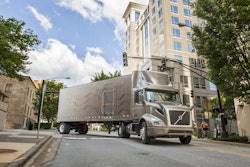
The aerodynamic and fuel-sipping Starship Initiative truck recently completed its cross-country test drive and now has some impressive numbers to report.
Shell Lubricants and the AirFlow Truck Company teamed up to build the truck and became the first to take a prototype like this across the U.S. The 2,300-mile trip through the southern U.S. included plenty of rain and wind courtesy of Tropical Storm Alberto.
Despite the far-from-perfect road and weather conditions, Shell reported today that the trip was a success. The Starship truck attained 178.4 ton-miles per gallon for freight ton efficiency—a nearly 248 percent improvement over the North America average freight ton efficiency of 72 ton-miles per gallon for trucks. Shell reports that freight ton efficiency is a more relevant statistic for judging the energy intensity associated with moving cargo from point A to point B since it combines the weight of cargo being moved with the amount of fuel consumed.

The final total truck and cargo weight was close to 73,000 pounds, which is 28 percent heavier than the average total gross vehicle weight of 57,000 pounds for a U.S. on-highway Class 8 truck.
The payload weighed in at 39,900 pounds, 77 percent more mass than the U.S. average payload of 22,500 pounds, and was comprised of clean reef material destined for a new offshore reef installation in Florida.
The Starship truck’s total average fuel economy was 8.94 miles per gallon, compared to the average U.S. fuel economy for transport trucks at 6.4 miles per gallon. The best fuel economy attained during the drive was 10.2 miles per gallon.
According to Shell, if all trucks in the U.S., 2 million of them, reached the overall fuel economy and freight ton efficiency performance of Starship, they would emit an estimated 229 million less tons of CO2 into the atmosphere per year. A reduction of 229 million tons would correspond to a 60 percent reduction in CO2emissions from the U.S. truck fleet, highlighting the benefit of the enhanced economy and increased loading strategy adopted within the Starship Initiative.

For the Shell Starship team, the cross-country journey brought several lessons and firsts. The trip provided Shell with an opportunity to test Shell ROTELLA T6 Ultra 5W-30 Full Synthetic engine oil in a cutting-edge vehicle prior to its introduction to market.
Shell credits the Starship’s strong freight ton efficiency to its lubricants technology, carefully thought through aerodynamics, including customized carbon fiber cab and full side skirts along the length of the trailer, Cummins X-15 Efficiency engine, low rolling resistance tires and a smart driving strategy.
Complementing the streamlined design of the truck was the addition of recent Department of Transportation-approved full video only mirrors that provided a broader, nearly 180-degree view on each side of the truck for the driver.

“These and other learnings are not the final results; they are simply the start of our ongoing learning,” Mainwaring said. “We’ll move forward to apply learnings from this test run and implement additional technologies on the truck for future testing. While it would be easy to say the Starship Initiative has been very successful, we know there is more we can do to continue to drive industry dialogue and share learnings moving forward.”
As new fuel economy and emission regulations loom on the horizon, you can keep up with the latest Starship Initiative activities by visiting www.shell.com/starship.
the need for continuing advances in fuel economy, the Starship Initiative has taken a step in the journey to target the world’s global energy challenge. To stay up-to-date on the latest Starship Initiative activities, visit www.shell.com/starship.













